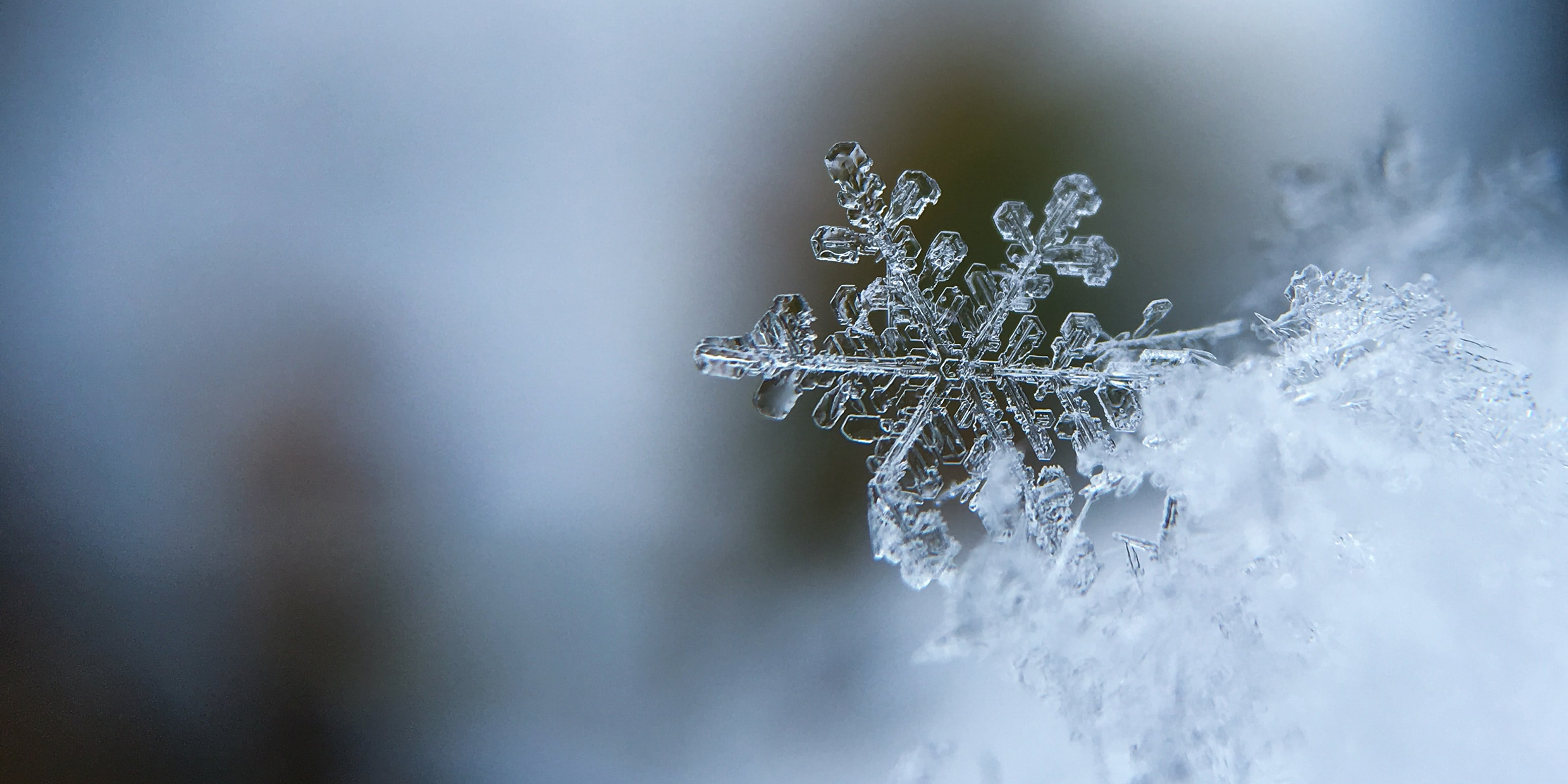Originally published 5 December 2000
One fat flake. Then two. Then dozens dancing in the air. One lands on the sleeve of my jacket — a perfect hexagon, an icon of some great ordering principle in nature. Hold out my arm. Another, and another. Each with an invisible heart of stone, a microscopic grain of atmospheric dust about which water molecules crystallized high in the storm. Now my sleeve is covered with flakes, patterns of flawless loveliness and infinite variability. The flakes seem static, the essence of rigidity, but I know that the molecules are impressed into their symmetries by atomic vibrations of exquisite sensitivity, molecular resonances, a kind of cold, wet cosmic music.
Hans Castorp, on Thomas Mann’s Magic Mountain, observed snowflakes on his sleeve, “little jewels, insignia, orders, agraffes.” He thought them terrifying, life-denying, icily regular in their forms. He was not quite right. A snowflake is indeed supremely ordered, its six-pointed form fixed for all eternity by the way two atoms of hydrogen cling to an atom of oxygen to make a molecule of water. It’s all there in the quantum laws that are the foundation of the universe. But there’s chaos, too, an element of randomness, which is why no two snowflakes look alike.
The first snowfall of the season. Remember those cold November afternoons of our youth when we looked up from our desks to see the snowflakes falling outside the classroom window. A buzz of joyfulness zipped from desk to desk until our teacher smiled and we took that as a signal that we could crowd to the window sills and feed our dreams of winter wonderlands. It didn’t stick, of course. The asphalt in the playground dampened but stayed black. Still, those fat, dancing flakes traced a calligraphy in the air that every child could read — boots, mittens, snow forts, sleds, skidding in ice, throwing snowballs, making snow angels in meadows of fresh white powder.
The thrill is no less now, fifty years on. Some things we never outgrow. When those first snowflakes fall, they excite some web of neurons deep in the brain that was wired in childhood and has resisted every effort of time to erase. And God knows time has done its best. Driveways that need to be shoveled. Dirty wet slush. Colds. Flu. Heating bills. Automobile accidents. Long dark days that seem to start in the middle of the night and end there, too. Piles of wet snowsuits, caps and mittens dripping all over the hardwood floors.
No wonder, then, that we like those water-and-flake-filled toy globes with winter scenes that always seem pristine — tiny villages, snowmen, Santa Claus, the nativity scene in Bethlehem, amid swirls of immaculate flakes, first snowfalls that never end. Tip the globe, the snow falls fresh, no ice, no slush, no cheerless dark. Those ever-popular globes tell us something about ourselves, about the selectivity of memory, about our ability to forget what we don’t like. Call it the First Snowfall Effect, the human capacity to put the best bright spin on nature’s motley script.
It’s this capacity for hope that separates us from non-living matter. “The snowflake eternally obeys its one and only law: Be thou six-pointed,” writes the naturalist Joseph Wood Krutch. The story of the snow was finished the day the universe was born, but the story of life is still in the telling. Life is “rebellious and anarchical,” Krutch writes. “It may hope and it may try.”
And so we hope and try, living in a world of our own imagining, struggling to escape the blind inevitably of nature’s laws, trying on new futures: Six points? Five? Seven? Ten? As Krutch reminds us, no living thing can be as icily beautiful as the snowflake, but no snowflake can know what beauty is. To be alive is to be in a world of chance and change, a little bit frightened by the snowflake’s perfect form, pretending — true or not — that we are truly free.
Forgetfulness offers a kind of release from nature’s endless cycles — seasonal, diurnal, life and death. Mothers suppress the memory of childbirth pain, remembering only the pleasure of new life. When daybreak comes, we forget the dark terrors of the predawn hours when we lay awake and wrestle with our private dreads. And when the first November snowflakes fall, we put out of our minds the harsh reality of February when we swear that, if it snows one more time, we’ll pack up and move to Florida.
Today, the air is filled with whirling flakes. I spread my arms in joyful welcome. “Hast thou entered into the treasure-house of the snow?” the Lord asked Job from the whirlwind. Here on my sleeve is the treasure. The world’s globe is tipped. Some wonderful capacity of being alive lets us forget what’s coming a month from now. Tip the globe. Tip. Our happy hope lets us make the world anew.



